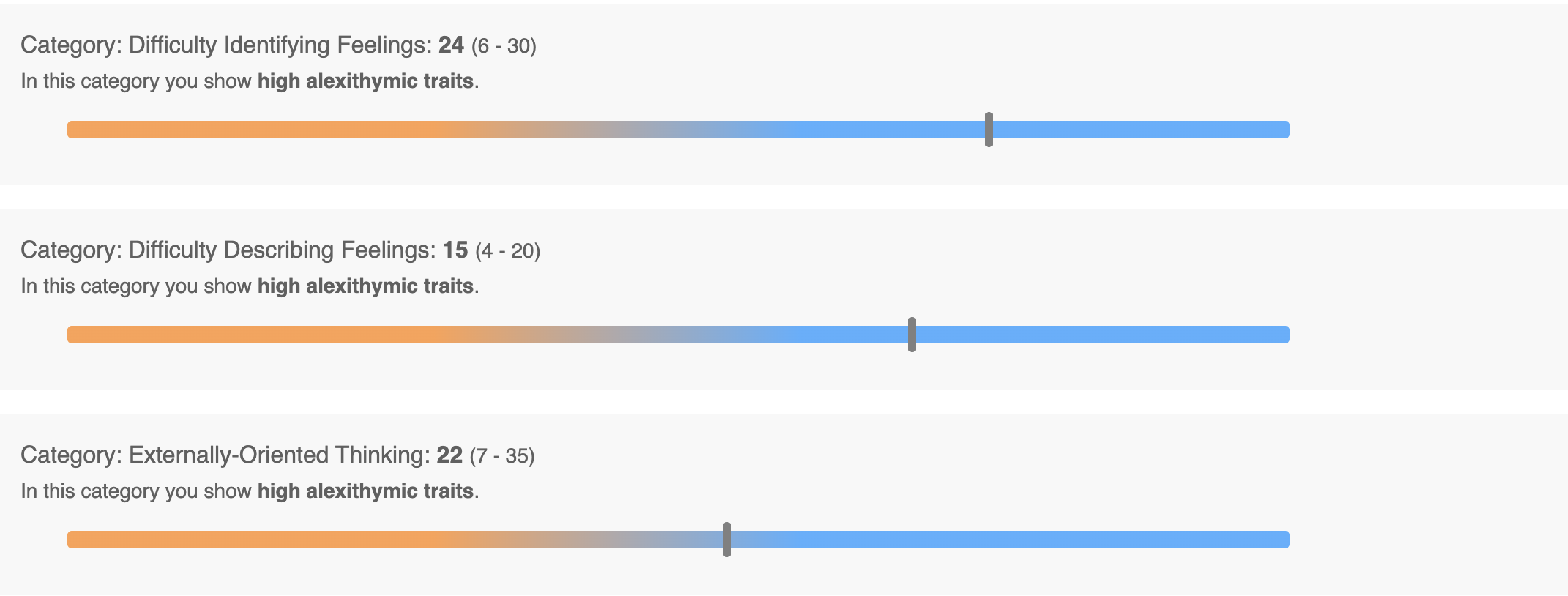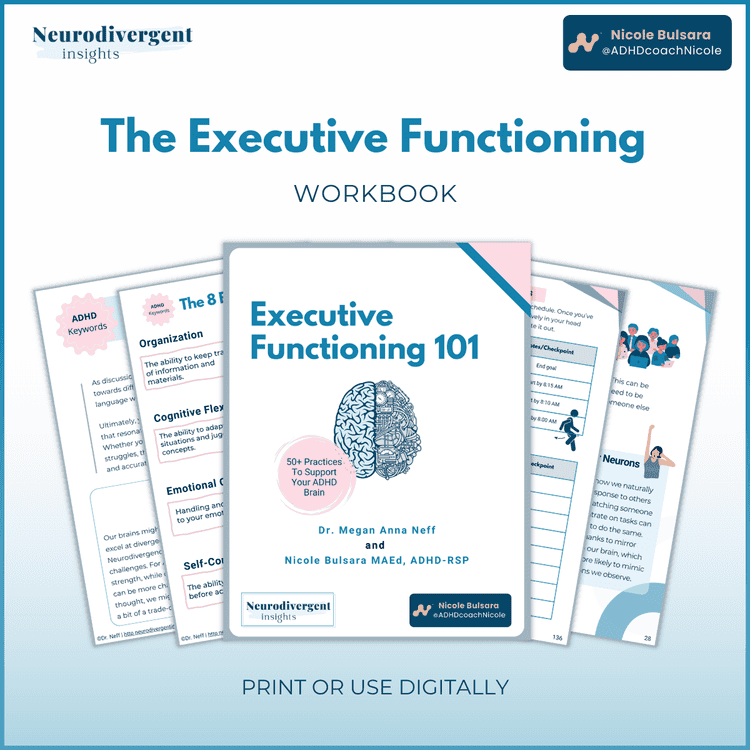Have you ever wondered why it’s so hard to answer the question, “how are you feeling?” or “where do you feel that?” Does it make you uncomfortable when people are processing their emotions around you? For years, I never understood why the simple question “how are you” stumped me so much. I am a psychologist; after all, isn’t my emotional IQ supposed to be sky-high? Once I learned what alexithymia was and took some online alexithymia tests, which confirmed I have alexithymia, it helped me have a framework for understanding many confusing experiences around emotions!
What is Alexithymia?
Alexithymia is characterized by difficulty identifying and describing emotions. Alexithymia can provide a useful framework for understanding our experiences with emotions. Until I had the language of alexithymia, there were plenty of other things I used to say; I would say:
I don’t do emotions.
I live in my head
Emotional people make me uncomfortable.
I express my emotions through my ideas.
I hate emotions (I accidentally let this one slip to my therapist in my appointment, to which they gently inquired into the irony of me being a Psychologist in training who “hates emotion”)
I would become tongue-tied when people asked me how I was and feel confused and ashamed around this. I suspect one reason I became a therapist is that it is a lot easier to ask the other person about their feelings than trying to explain my own! And it turns out you can build friends by being a good listener, so it was a convenient way of masking my difficulties.
Beyond causing communication and relationship difficulties, alexithymia also makes it more difficult to regulate our emotions. Because our emotions are often experienced as a chaotic jumble, we more easily become overwhelmed by them and are more prone to go to unhealthy coping.
For all these reasons and more, it can be beneficial to know if you have high alexithymic traits. Alexithymia is not a mental health condition (it is a personality trait). However, it does co-occur at high rates among several mental health conditions and forms of neurodivergence.
For more of a deep dive into what alexithymia is, you can read my article about it here.
The Alexithymia Test
Taking online alexithymia tests can help us better understand ourselves and gain language to describe our experiences to others. There are several alexithymia quizzes and tests out there. The two most widely used online alexithymia tests are the Toronto Alexithymia Scale (TAS-20) and the Online Alexithymia Questionnaire. Following is a description of each test and links for where you can take them for free.
The Toronto Alexithymia Scale
The Toronto Alexithymia Scale is the most commonly used test of alexithymia. It is 20 question scale designed for people 16 years and older. It takes 5-10 minutes to complete. It measures three factors:

1) Difficulty identifying feelings
2) Difficulty describing emotions which are core features of alexithymia
3) Externally-oriented thinking
The TAS-20 has been widely used in clinical research and has robust psychometrics (meaning it has high accuracy, validity, and reliability).
Pros: It is short and quick to take and is a highly reliable measure.
Cons: Some of the questions are vague and ambiguous. You don’t get direct feedback about the subscales.
Online Alexithymia Questionnaire
The Online Alexithymia Questionnaire is a 37-questions designed for adults. It takes about 10-15 minutes to complete. The online alexithymia test has expanded previous alexithymia measures to include more dimensions of alexithymia. It includes seven different subscales:

1) Difficulty identifying emotions
2) Difficulty describing feelings
3) Vicarious interpretation of feelings
4) Externally-oriented thinking
5) Restricted imaginative processes
6) Problematic interpersonal relationships
7) Sexual difficulties and disinterest
Pros: Will provide you with visual results (show your results on bars and provides your scores in 7 different areas).
Cons: Is not widely used or validated within medical research.
Interpreting Alexithymia Test Results
The Toronto Alexithymia Scale and Online Alexithymia Questionnaire are scored differently. Here is a breakdown of how to interpret your results:
Toronto Alexithymia Scale Scoring
The total possible score is 100 (the higher your score, the more alexithymic traits you have). Additionally, you will receive subscores for the three subcategories.
 Online Alexithymia Questionnaire
Online Alexithymia Questionnaire
The Online Alexithymia Questionnaire provides a bar graph. I appreciate the way they visually present the scoring. The results will inform you if you have “no, some, or high” alexithymic traits overall, and it will also show you your scores for each of the seven subcategories. Below is an example of what the score report looks like.
 Bar graph results from the online alexithymia questionnaire
Bar graph results from the online alexithymia questionnaire
Difficulty Identifying Emotions
Difficulty identifying emotions is a core feature of alexithymia. People with high alexithymic traits in this area often experience a great deal of confusion about their internal experience —including emotions and body sensations. They may have a vague feeling of something wrong but have difficulty pinpointing the emotion. Their bodily sensations often cause confusion, and they struggle to distinguish between emotions and bodily sensations (for example, the difference between hunger and anxiety).
Difficulty in this area is linked with depression, non-suicidal self-harm, and suicidal behavior (Cerutti et al., 2018). Identifying emotions play a crucial role in our ability to regulate emotions which is likely one of the reasons this is connected with more emotional turmoil and depression.
*Note: This is often connected to underlying interoception difficulties.
Difficulty Describing Emotions
Describing emotions is slightly different than identifying emotions. Identifying feelings is more internal, and describing emotions is more external. Difficulty describing feelings refers to difficulty with:
Finding words for your feelings and
Being able to express these feelings to others
People who struggle with this experience difficulty labeling emotions and finding the right words to describe their feelings. Descriptors of emotions may be vague, general, and diffuse. Such people may struggle with responding to questions such as “how are you?” Difficulty describing emotions is associated with more relationship difficulty.
Vicarious Interpretation of Feelings
People with high alexithymic traits here rely on others to help interpret their feelings. Examples of vicarious interpretation of feelings would include:
Asking other people what they would feel if they were in your situation to better understand what to do
Relying on other people to interpret the emotional details of a social situation
People with high alexithymia traits here often experience limited affective and cognitive empathy and struggle to understand what others are experiencing. People with high alexithymic traits in this area often experience more relationship difficulties.
Restricted Imagination
Many people with alexithymia (but not all) have a diminished fantasy life with limited imaginative capacities. A restricted imagination is characterized by diminished fantasy life with limited interest in fantasy and creative processes.
People with high alexithymic traits here are oriented toward the concrete world of facts and pragmatics with little interest in fantasy and creative processes. They may have little interest in fantasy, creative efforts, and art and are unlikely to spend time daydreaming. They are often great pragmatic thinkers who live in the concrete world of facts and data.
Externally Oriented Thinking
A person with high externally oriented thinking focuses their thoughts externally (vs. internally). An externally oriented thinker focuses their energy on external events and tends to avoid focusing on internal experiences. When a person has high alexithymic traits in this area, they experience difficulty attending to their emotions and inner states. There is a lack of curiosity about what is happening internally for the person, which is associated with a reduced ability to experience positive emotions.
Interpersonal Difficulties
The last two subscales aren’t specifically part of the formal definition of alexithymia but often correlate with alexithymia.
Alexithymia has been linked to difficulties with interpersonal difficulties, which are likely impacted by difficulty emotionally connecting with others, difficulty with empathy, and perspective-taking. Alexithymia has been linked to difficulties with empathy (difficulty perceiving other people’s perspectives and understanding their feelings and intentions) (Goerlich, 2018), making and deepening relationships more difficult.
Sexual Difficulties and Disinterest
While not a primary feature of alexithymia, alexithymia is often associated with sexual difficulties or disinterest. Such as reduced sexual satisfaction and greater detachment from sexual partners. There is a higher rate of people who identify as asexual/aromantic within the alexithymic population.
This may be related to several factors:
1) alexithymia is associated with more negative emotions, which impact sexual attitudes
2) alexithymia often results in a more avoidant/detached attachment style, which lends to a more avoidant sexual style (Scimeca et al., 2013).
People with alexithymia are also more likely to identify as asexual (source). This may be one reason there is a higher rate of asexual people within the Autistic population.
What to do with Your Alexithymia Test Results
With intentionality and hard work, alexithymia can be improved. Alexithymia is often an extension of interoception difficulties (difficulty with body awareness). And research has shown that interoception awareness can be improved with practice.
Many exercises aimed to increase awareness of emotions start by increasing awareness of bodily sensations and signals. If you struggle with alexithymia, I recommend you also do some learning and work around interoception. You can check out my workbooks on alexithymia and interoception, where I provide exercises aimed at increasing your emotional and bodily awareness.
Summary: the Alexithymia Test
Alexithymia is a helpful concept that provides a framework for discussing a cluster of experiences. It includes difficulty identifying emotions, describing feelings, restricted imagination, and externally-oriented thinking.
It can be empowering when people have the language to explain these experiences. Once we understand what is happening and why we have more agency to make decisions that will help us, it also provides language to communicate our needs and differences with loved ones.
The Online Alexithymia Test and Toronto Alexithymia Scale can be valuable tools for learning more about how you experience and process emotions. It’s helpful to remember that alexithymia is not a mental health diagnosis but a personality trait (although it may be helpful to bring this up with your therapist as it will definitely impact your therapy experience!).
This post was proofread by Grammarly, my go-to for proofreading and catching all the details I naturally miss! Grammarly is entirely free to use. Click here to give it a try.










